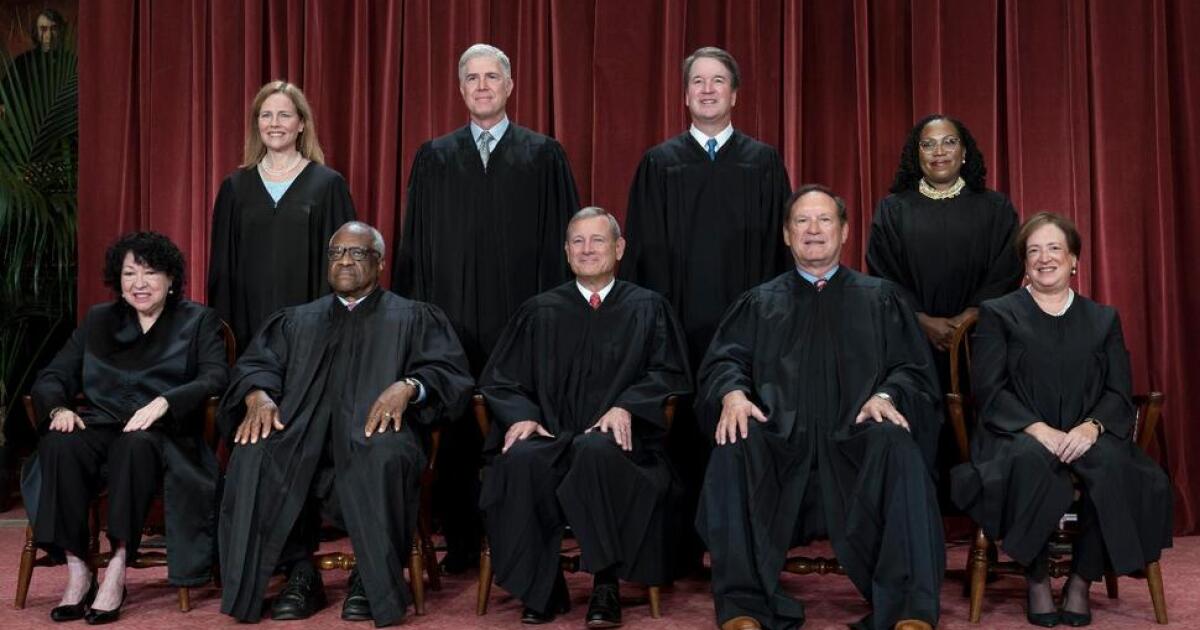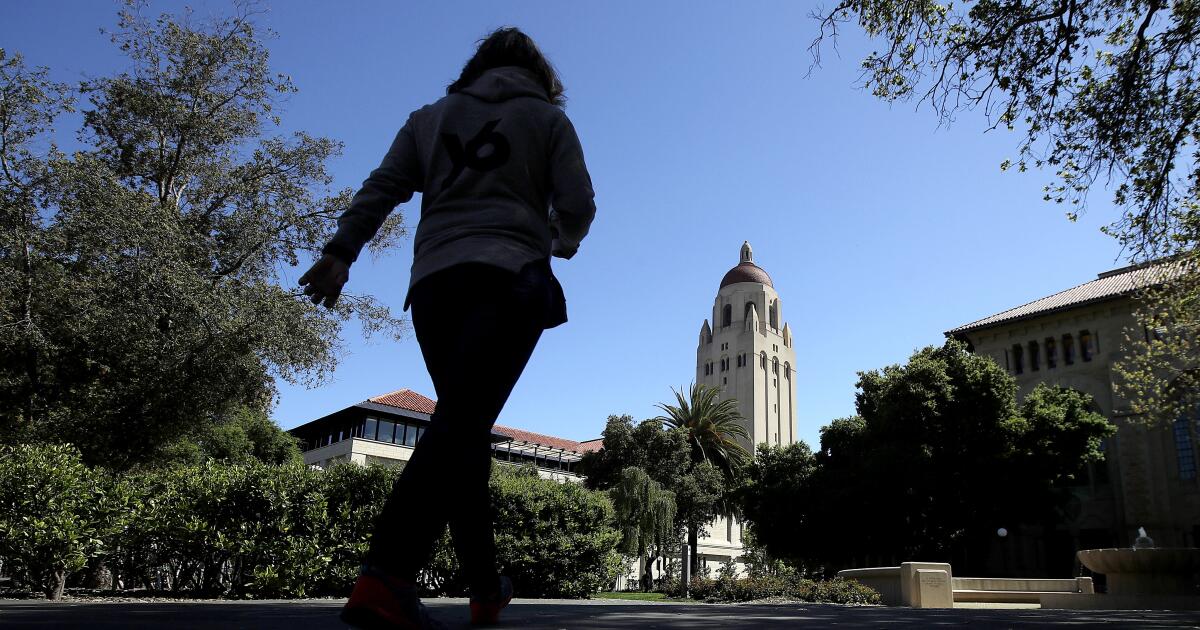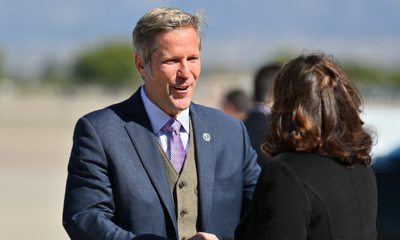Business
Column: What FDR could advise Biden about reforming the Supreme Court — tread lightly

If it’s true that as Mark Twain supposedly said, history doesn’t repeat itself but it often rhymes, then we are about to embark on a poetry slam for the ages, with the Supreme Court as its theme.
President Biden on Monday unveiled a package of proposals to rein in a court that has seen public confidence reach a low ebb not recorded by the Gallup Organization in readings dating back to 1973.
Most significantly, he is calling for 18-year term limits for Supreme Court justices and the imposition by Congress of binding conduct and ethics rules requiring the justices to “disclose gifts, refrain from public political activity, and recuse themselves from cases in which they or their spouses have financial or other conflicts of interest.”
Term limits would… make timing for Court nominations more predictable and less arbitrary; and reduce the chance that any single Presidency imposes undue influence for generations to come.
— President Biden on his Supreme Court reform plan
He is also proposing a constitutional amendment to neutralize a court decision appearing to give former presidents immunity for crimes committed while in office.
The template for these proposals is Franklin Roosevelt’s 1937 plan to “pack” the court by allowing presidents to appoint a new justice when any sitting justice failed to resign or retire within six months of turning 70, up to a maximum of six new justices.
The manifest goal was to dilute the influence of a cadre or conservative justices who had overruled almost every New Deal law or regulation that had come before them, as well as several other measures.
If FDR could counsel Biden today, he might warn him to move carefully; FDR’s court-packing scheme went down in flames amid congressional opposition, cut deeply into the popularity that had brought him a landslide reelection victory in the 1936 election, and brought the New Deal to a screeching halt. It also represented a moment in which FDR lost his unique ability to gauge the popular mood and act upon it.
The politics of Supreme Court reform today resemble those of 1937 in many ways, though as Twain’s supposed quip suggests, there are significant differences. Let’s look at the differences first.
Roosevelt was then at the outset of his second term, riding high on an electoral victory that may have given him a greater sense of his political omnipotence than he actually possessed. Biden, of course, is less than six months away from the end of his presidency. Roosevelt could look ahead at four more years of policymaking; Biden may be more focused on cementing his legacy of progressive achievements by bequeathing the nation a reformed Supreme Court.
Both presidents may have felt they had nothing to lose by taking on what seemed to be the most revered of the three branches of government, albeit for different reasons — Roosevelt because nothing could chip away at his popularity, Biden because his own term in office can’t be affected by the fate of his reform proposals.
Roosevelt was faulted for springing his scheme on an unsuspecting public and Congress. Notwithstanding public discontent with the court, its reform hadn’t been an issue in the presidential campaign recently ended. FDR had not spoken publicly about the court after a series of anti-New Deal rulings in 1935 and 1936 except after one ruling in which he accused the court of relegating the country to “the horse-and-buggy definition of interstate commerce.”
Instead, he blindsided the nation by announcing his plan in a speech on Feb. 5. To his surprise, voters and legislators — including reliable New Deal supporters on Capitol Hill — reacted with fury.
It was not merely the secrecy in which the scheme had been plotted that its critics found dismaying. FDR’s stated rationale, which was that the aging justices were overworked and needed help to manage their docket, was transparently deceptive.
That rationale might have looked superficially reasonable at first, since the oldest member of the court’s so-called Four Conservative Horsemen, Willis Van Devanter, had been born during the administration of James Buchanan, which supposedly rendered him utterly out of step with the politics of the 1930s.
However, the oldest justice on the court, Louis Brandeis, was even older — at 80, he had been born during the administration of Franklin Pierce, Buchanan’s predecessor, but nevertheless was the court’s liberal lion and not an impediment to the New Deal.
Biden seems to have absorbed the lessons of FDR’s failed effort. He has been telegraphing for weeks that he is contemplating Supreme Court reforms. His proposals are not as radical as expanding the court outright, but they address some of the most evident issues driving the court’s public standing into the sub-basement: a conservative majority that has shown no respect for values and rights long cherished by most Americans, and a record of financial grifting and overt partisanship, chiefly by conservative Justices Clarence Thomas and Samuel A. Alito Jr.
As in 1937, there is a sense that the court has taken aim at progressive principles and laws, running roughshod over individual rights.
The court’s direction has been led by a conservative majority including three judges appointed by Donald Trump — among them Neil M. Gorsuch, who slid into a seat kept open by Senate Republicans’ refusal to even consider Barack Obama’s nomination of Merrick Garland to the late Antonin Scalia’s seat; and Amy Coney Barrett, rushed to confirmation by Senate Republicans in October 2020 only 38 days before the election that would unseat Trump and bring Biden to the White House.
Barrett took the seat vacated by the death of Ruth Bader Ginsburg, one of the most liberal justices ever to sit on the court.
The three Trump judges were in the majority that in 2022 overturned Roe vs. Wade, the decision that had protected women’s reproductive health rights since 1973.
It may be useful to compare the court’s behavior in recent years with what provoked FDR into launching his court-packing scheme.
The court’s distaste for elements of the New Deal was assumed as the Roosevelt administration proceeded to remake the U.S. economy. But it didn’t become palpable until it issued three decisions on May 27, 1935, a date that would become known to progressives as “Black Monday.”
In the first decision, the court overturned Roosevelt’s ouster of a reactionary member of the Federal Trade Commission, placing a limit on a president’s authority over executive officers. The court then invalidated a farm mortgage law because it applied to existing mortgages, not just new ones. Then came the court’s invalidation of the National Recovery Administration, through which the government had tried to regiment competition throughout the economy to help dig the country out of the Depression.
All three decisions were unanimous, but they still signaled that a conservative cadre was poised to undermine New Deal initiatives due to come before the justices. In 1936, the court narrowed the authority of the Securities and Exchange Commission and invalidated a relief program for coal companies. Most significantly, it overturned a New York minimum wage law in a decision known as Tipaldo, after its detestable protagonist, the owner of a laundry who had been cheating his laundresses of their legal wages.
Condemnation of the Tipaldo decision came from across the entire political spectrum. “If this decision does not outrage the moral sense of the country, then nothing will,” FDR’s Interior secretary, Harold Ickes, wrote in his diary. Conservatives were dismayed that the decision undercut their argument that labor rights should remain in the hands of the states — how could that be, if the Supreme Court had overturned a state minimum wage law?
Roosevelt and his fellow progressives foresaw that the court would invalidate the entire New Deal. For a time, FDR seemed content to let that happen, reasoning that it would help him get a constitutional amendment enacted that would allow Congress to save any law the court deemed unconstitutional by reenacting it. If the court kept overturning the New Deal, he reasoned, there would be “marching farmers and marching miners and marching workingmen throughout the land.”
In the end, he chose to go with the court-packing scheme, recognizing that it fit within the constitutional provision giving Congress the unquestioned right to dictate the size of the court.
For many Americans today, the court’s Dobbs decision overturning Roe vs. Wade has supplanted its 1857 Dred Scott decision as the worst in its history. By relegating abortion to a state-level decision, Dobbs has spawned a patchwork of punitive state laws that have life-threatening ramifications for pregnant women (among many other shortcomings).
Public distaste for Dobbs, as was the case with Tipaldo, has been manifest. Since it was handed down in June 2022, every single state initiative to protect women’s reproductive rights has prevailed at the ballot box. The chief weapons in the antiabortion camp’s quiver have been efforts to stymie referendum and initiative votes by changing the ballot box rules, as has been tried in Florida and Ohio.
Biden’s proposal to establish staggered 18-year terms for justices has several virtues. One is that it would rebalance a court on which GOP appointees are arguably overrepresented. From 1960 through this year, Republicans held the White House for 32 years and Democrats for 31, almost an even split. But in that period, Republicans have appointed 15 justices and Democrats only ten. Under Biden’s proposal, every president would have the opportunity to appoint two justices during each four-year term.
“Term limits would … make timing for Court nominations more predictable and less arbitrary; and reduce the chance that any single Presidency imposes undue influence for generations to come,” the Biden White House says.
The one flaw in the proposal is that it could require a constitutional amendment. The Constitution states that federal justices may serve “during good behavior,” but expert opinion is divided over whether that bars Congress from imposing any other conditions on their service.
It’s worth noting that the Supreme Court was so unnerved by the groundswell of criticism it faced after Tipaldo that Chief Justice Charles Evans Hughes engineered an about-face, orchestrating a 5-4 opinion upholding a Washington state minimum wage law that was almost identical to the New York law it had overturned, also by 5 to 4. That helped to take the wind out of FDR’s scheme. The change would forever be known as “the switch in time that saved nine.” The court never overturned another New Deal initiative.
But few such opportunities for an about-face are on the horizon. The damage this court has done to individual rights and the rule of law is manifest. Biden’s sense is that the time is ripe for reform, and that this time the public may go along.

Business
U.S. Space Force awards $1.6 billion in contracts to South Bay satellite builders

The U.S. Space Force announced Friday it has awarded satellite contracts with a combined value of about $1.6 billion to Rocket Lab in Long Beach and to the Redondo Beach Space Park campus of Northrop Grumman.
The contracts by the Space Development Agency will fund the construction by each company of 18 satellites for a network in development that will provide warning of advanced threats such as hypersonic missiles.
Northrop Grumman has been awarded contracts for prior phases of the Proliferated Warfighter Space Architecture, a planned network of missile defense and communications satellites in low Earth orbit.
The contract announced Friday is valued at $764 million, and the company is now set to deliver a total of 150 satellites for the network.
The $805-million contract awarded to Rocket Lab is its largest to date. It had previously been awarded a $515 million contract to deliver 18 communications satellites for the network.
Founded in 2006 in New Zealand, the company builds satellites and provides small-satellite launch services for commercial and government customers with its Electron rocket. It moved to Long Beach in 2020 from Huntington Beach and is developing a larger rocket.
“This is more than just a contract. It’s a resounding affirmation of our evolution from simply a trusted launch provider to a leading vertically integrated space prime contractor,” said Rocket Labs founder and chief executive Peter Beck in online remarks.
The company said it could eventually earn up to $1 billion due to the contract by supplying components to other builders of the satellite network.
Also awarded contracts announced Friday were a Lockheed Martin group in Sunnyvalle, Calif., and L3Harris Technologies of Fort Wayne, Ind. Those contracts for 36 satellites were valued at nearly $2 billion.
Gurpartap “GP” Sandhoo, acting director of the Space Development Agency, said the contracts awarded “will achieve near-continuous global coverage for missile warning and tracking” in addition to other capabilities.
Northrop Grumman said the missiles are being built to respond to the rise of hypersonic missiles, which maneuver in flight and require infrared tracking and speedy data transmission to protect U.S. troops.
Beck said that the contracts reflects Rocket Labs growth into an “industry disruptor” and growing space prime contractor.
Business
California-based company recalls thousands of cases of salad dressing over ‘foreign objects’

A California food manufacturer is recalling thousands of cases of salad dressing distributed to major retailers over potential contamination from “foreign objects.”
The company, Irvine-based Ventura Foods, recalled 3,556 cases of the dressing that could be contaminated by “black plastic planting material” in the granulated onion used, according to an alert issued by the U.S. Food and Drug Administration.
Ventura Foods voluntarily initiated the recall of the product, which was sold at Costco, Publix and several other retailers across 27 states, according to the FDA.
None of the 42 locations where the product was sold were in California.
Ventura Foods said it issued the recall after one of its ingredient suppliers recalled a batch of onion granules that the company had used n some of its dressings.
“Upon receiving notice of the supplier’s recall, we acted with urgency to remove all potentially impacted product from the marketplace. This includes urging our customers, their distributors and retailers to review their inventory, segregate and stop the further sale and distribution of any products subject to the recall,” said company spokesperson Eniko Bolivar-Murphy in an emailed statement. “The safety of our products is and will always be our top priority.”
The FDA issued its initial recall alert in early November. Costco also alerted customers at that time, noting that customers could return the products to stores for a full refund. The affected products had sell-by dates between Oct. 17 and Nov. 9.
The company recalled the following types of salad dressing:
- Creamy Poblano Avocado Ranch Dressing and Dip
- Ventura Caesar Dressing
- Pepper Mill Regal Caesar Dressing
- Pepper Mill Creamy Caesar Dressing
- Caesar Dressing served at Costco Service Deli
- Caesar Dressing served at Costco Food Court
- Hidden Valley, Buttermilk Ranch
Business
They graduated from Stanford. Due to AI, they can’t find a job

A Stanford software engineering degree used to be a golden ticket. Artificial intelligence has devalued it to bronze, recent graduates say.
The elite students are shocked by the lack of job offers as they finish studies at what is often ranked as the top university in America.
When they were freshmen, ChatGPT hadn’t yet been released upon the world. Today, AI can code better than most humans.
Top tech companies just don’t need as many fresh graduates.
“Stanford computer science graduates are struggling to find entry-level jobs” with the most prominent tech brands, said Jan Liphardt, associate professor of bioengineering at Stanford University. “I think that’s crazy.”
While the rapidly advancing coding capabilities of generative AI have made experienced engineers more productive, they have also hobbled the job prospects of early-career software engineers.
Stanford students describe a suddenly skewed job market, where just a small slice of graduates — those considered “cracked engineers” who already have thick resumes building products and doing research — are getting the few good jobs, leaving everyone else to fight for scraps.
“There’s definitely a very dreary mood on campus,” said a recent computer science graduate who asked not to be named so they could speak freely. “People [who are] job hunting are very stressed out, and it’s very hard for them to actually secure jobs.”
The shake-up is being felt across California colleges, including UC Berkeley, USC and others. The job search has been even tougher for those with less prestigious degrees.
Eylul Akgul graduated last year with a degree in computer science from Loyola Marymount University. She wasn’t getting offers, so she went home to Turkey and got some experience at a startup. In May, she returned to the U.S., and still, she was “ghosted” by hundreds of employers.
“The industry for programmers is getting very oversaturated,” Akgul said.
The engineers’ most significant competitor is getting stronger by the day. When ChatGPT launched in 2022, it could only code for 30 seconds at a time. Today’s AI agents can code for hours, and do basic programming faster with fewer mistakes.
Data suggests that even though AI startups like OpenAI and Anthropic are hiring many people, it is not offsetting the decline in hiring elsewhere. Employment for specific groups, such as early-career software developers between the ages of 22 and 25 has declined by nearly 20% from its peak in late 2022, according to a Stanford study.
It wasn’t just software engineers, but also customer service and accounting jobs that were highly exposed to competition from AI. The Stanford study estimated that entry-level hiring for AI-exposed jobs declined 13% relative to less-exposed jobs such as nursing.
In the Los Angeles region, another study estimated that close to 200,000 jobs are exposed. Around 40% of tasks done by call center workers, editors and personal finance experts could be automated and done by AI, according to an AI Exposure Index curated by resume builder MyPerfectResume.
Many tech startups and titans have not been shy about broadcasting that they are cutting back on hiring plans as AI allows them to do more programming with fewer people.
Anthropic Chief Executive Dario Amodei said that 70% to 90% of the code for some products at his company is written by his company’s AI, called Claude. In May, he predicted that AI’s capabilities will increase until close to 50% of all entry-level white-collar jobs might be wiped out in five years.
A common sentiment from hiring managers is that where they previously needed ten engineers, they now only need “two skilled engineers and one of these LLM-based agents,” which can be just as productive, said Nenad Medvidović, a computer science professor at the University of Southern California.
“We don’t need the junior developers anymore,” said Amr Awadallah, CEO of Vectara, a Palo Alto-based AI startup. “The AI now can code better than the average junior developer that comes out of the best schools out there.”
To be sure, AI is still a long way from causing the extinction of software engineers. As AI handles structured, repetitive tasks, human engineers’ jobs are shifting toward oversight.
Today’s AIs are powerful but “jagged,” meaning they can excel at certain math problems yet still fail basic logic tests and aren’t consistent. One study found that AI tools made experienced developers 19% slower at work, as they spent more time reviewing code and fixing errors.
Students should focus on learning how to manage and check the work of AI as well as getting experience working with it, said John David N. Dionisio, a computer science professor at LMU.
Stanford students say they are arriving at the job market and finding a split in the road; capable AI engineers can find jobs, but basic, old-school computer science jobs are disappearing.
As they hit this surprise speed bump, some students are lowering their standards and joining companies they wouldn’t have considered before. Some are creating their own startups. A large group of frustrated grads are deciding to continue their studies to beef up their resumes and add more skills needed to compete with AI.
“If you look at the enrollment numbers in the past two years, they’ve skyrocketed for people wanting to do a fifth-year master’s,” the Stanford graduate said. “It’s a whole other year, a whole other cycle to do recruiting. I would say, half of my friends are still on campus doing their fifth-year master’s.”
After four months of searching, LMU graduate Akgul finally landed a technical lead job at a software consultancy in Los Angeles. At her new job, she uses AI coding tools, but she feels like she has to do the work of three developers.
Universities and students will have to rethink their curricula and majors to ensure that their four years of study prepare them for a world with AI.
“That’s been a dramatic reversal from three years ago, when all of my undergraduate mentees found great jobs at the companies around us,” Stanford’s Liphardt said. “That has changed.”
-

 Iowa6 days ago
Iowa6 days agoAddy Brown motivated to step up in Audi Crooks’ absence vs. UNI
-

 Iowa1 week ago
Iowa1 week agoHow much snow did Iowa get? See Iowa’s latest snowfall totals
-

 Maine4 days ago
Maine4 days agoElementary-aged student killed in school bus crash in southern Maine
-

 Maryland6 days ago
Maryland6 days agoFrigid temperatures to start the week in Maryland
-

 Technology1 week ago
Technology1 week agoThe Game Awards are losing their luster
-

 South Dakota6 days ago
South Dakota6 days agoNature: Snow in South Dakota
-

 New Mexico4 days ago
New Mexico4 days agoFamily clarifies why they believe missing New Mexico man is dead
-

 Nebraska1 week ago
Nebraska1 week agoNebraska lands commitment from DL Jayden Travers adding to early Top 5 recruiting class




















